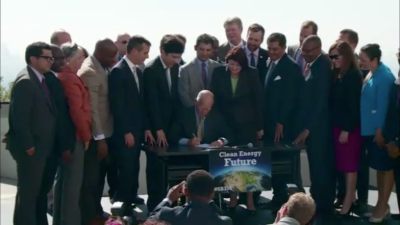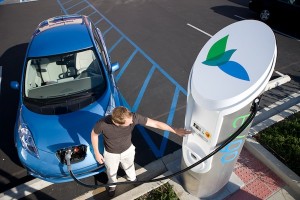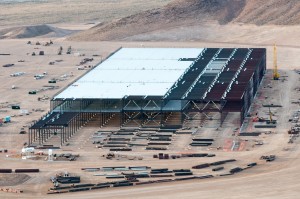Thursday I’m off to attend the UN climate change negotiations in Paris, primarily to highlight California’s effort to achieve a strong subnational agreement on greenhouse gas reductions. The “Under 2 MOU” is an impressive commitment by diverse subnational entities to keep warming to under two degrees Celsius by 2100. It already has 57 signatories, constituting the largest combined GDP in the world.
I’m looking forward to the trip, as I hope to learn a lot and meet people working on climate change all around the globe. But I have to confess, I’ve been a longtime skeptic of the UN process on climate change and am still unsure of what can be meaningfully gained there this time.
If we want to solve climate change, the world needs to do two things: put a meaningful price on carbon and reduce the cost of clean technologies, like solar panels and batteries. As I look to Paris, I wonder what authority the UN and the high-level attendees there have to actually make progress on those two fronts.
In terms of setting a price on carbon, it seems politically impossible that we’d ever have a UN-mandated carbon tax. That price will have to come from nations willing to impose it, and that means votes from members of parliaments and congresses across the globe (or party leaders, if we’re talking dictatorships here). Those decision-making bodies will be hardly represented in Paris, or bound by what comes out of it, as it seems most negotiators are agency heads and their deputies. In other words, President Obama and John Kerry do not have authority to impose a national carbon tax in the United States, they need congressional representatives to vote for it, and they won’t — at least in the current congress.
On the clean technology front, the UN may be better suited to develop a pot of money for rich nations to fund for clean tech. Already we’ve seen Bill Gates and other wealthy people step up for a “clean innovation” fund. So maybe we’ll see some progress there. But again, much of the support for clean technology will come from domestic programs, like the U.S. solar tax credit or California’s energy storage mandate. The people who make those decisions won’t be in attendance or negotiating and won’t have to abide by any resulting agreement.
So is Paris pointless? Well, sure, if we don’t get a good agreement. But if we do, what’s the upside? For starters, it can’t hurt to have a strong, international political signal that countries everywhere are willing to do something on climate. Maybe that statement will embolden decision-makers in these various countries to follow through on the needed policies, described above. And at a minimum, it could be useful to have information-sharing among the countries and a framework for more aggressive action in future years. So all of that is reason to support what’s happening in Paris.
I don’t mean to be a Debbie Downer, but I also don’t want the UN process to give everyone a false sense of progress, or distract from the real work that needs to be done. That work is happening now in places like California, Germany, Japan and other progressive states and nations. They need support and action to demonstrate to the world how to reduce emissions and grow the economy. Because ultimately those examples are what will motivate action in other places — not a voluntary international agreement.
I may return from Paris singing a different tune on the negotiations. But before I go, perhaps in the spirit of Pope Francis, I feel compelled to confess this pessimism.
BP isn’t exactly synonymous with clean and green energy, given the oil blowout in their Deepwater Horizon rig in the Gulf of Mexico back in 2010. But their analysis of the future of green energy is pretty positive [PDF]. As Greenbiz summarizes:
Bringing together previously internal analysis from BP’s energy experts, the document predicts the world will have a plentiful supply of affordable energy through the next few decades thanks to advances in all forms of energy technologies — from battery storage innovations to better extraction techniques for oil.
BP predicts the global energy system will remain heavily reliant on fossil fuels for decades to come. However, it also envisages strong growth potential for clean energy systems and supporting technology such as battery storage and electric vehicles.
What struck me among the five key points was #3, regarding the need for — and effect of — carbon pricing on future energy scenarios:
3. Carbon pricing will have a massive impact on competitiveness of renewables
Without a carbon price, gas and coal will remain the lowest-cost options for generating electricity in North America through 2050, according to the BP analysis. However, with the introduction of a relatively modest carbon price of $40 per tonne of CO2, new-build gas and renewables will start to displace coal.
With a higher carbon price — $80 per tonne of CO2 — onshore wind will be cost-competitive with natural gas by 2050, according to BP. This is based on analysis that applies a grid integration cost to renewables because of their intermittent energy supply.
This conclusion points to the importance of the international talks in Paris next month, where for the first time international negotiators may finally agree to even a modest floor on carbon pricing worldwide. We’ll need it as something to build on, while subnational entities like California and more progressive nations move forward to implement their own carbon pricing, either through cap-and-trade or direct taxes.
The Volkswagen emissions cheating scandal is another sad example of corporate malfeasance. For those not following the story, the basics are as follows: Volkswagen secretly installed “defeat devices” on approximately 11 million vehicles worldwide that could detect when the cars were being tested for emissions and then reduce the emissions to avoid being penalized. While the vehicles performed well during laboratory testing, in reality the emissions were up to 40 times the legal limit. You can see the map of affected areas from the pollution via Grist here.
So what remedies should California, as the state most immediately affected, seek from VW? At a minimum, state leaders should use the opportunity to bolster reduced emissions from vehicles going forward. And that means improving the deployment of battery electric technologies in vehicles.
California has gone down this path before. When Enron and other energy companies defrauded electricity ratepayers with the rolling black-outs in California back in 2000 and 2001, the state eventually settled with NRG, the corporate entity that assumed the liability through corporate acquisitions. State negotiators required that NRG spend $100 million on electric vehicle charging infrastructure.
But that settlement has so far not worked out well. NRG is way behind schedule and state auditors are investigating what’s going on. So state leaders need to learn from that experience and find a more direct way for VW to pay for its malfeasance and pollution.
A relatively simple way to do it would be to require VW, via settlement terms, to purchase a set amount of “zero emission vehicle (ZEV)” credits from automakers making battery electrics. That would boost their supply and reduce the costs of electric vehicles. Or VW could pay into a fund that reduces the cost of purchasing or leasing electric vehicles, via a point-of-sale cash rebate, for example. And to be clear, these requirements should not be the only settlement terms, but the ones directly related to repairing the harm to the environment from this cheating.
Of course, we have years of litigation to come on this scandal. But state leaders should start thinking now about how to make some lemonade out of these bitter VW lemons, while learning from past experiences.
 Kauai island’s electricity co-op (KIUC) is running circles around pretty much every other utility in the U.S. when it comes to renewables and energy storage. The utility just brought online Hawaii’s largest solar installation to date, with a 12 megawatt facility.
Kauai island’s electricity co-op (KIUC) is running circles around pretty much every other utility in the U.S. when it comes to renewables and energy storage. The utility just brought online Hawaii’s largest solar installation to date, with a 12 megawatt facility.
But the bigger news is that the solar PV is paired with a 6 megawatt lithium ion battery system, as UtilityDive reports. The 60-acre facility will supply 20 percent of the island’s annual power needs.
What about the cost? Well, given that Hawaii imports diesel fuel to burn for electricity, this plant will be an economic winner. KIUC announced that the project will save the utility $250,000 each month on operating costs alone, with the storage helping to smooth the intermittent solar power.
Overall, Kauai is lapping everyone else when it comes to renewables. California just patted itself on the back for setting a goal of 50% renewables by 2030, which is great. But Kauai is on the way to meeting its goal of 38% renewables just by the end of 2015, with 50% by 2023 and 100% renewables by 2045, as a new Hawaii state law will require.
This progress shows what can happen when you have a cooperative ownership model for electricity, as opposed to an investor-owned utility or even municipally owned utility. It also helps of course that Hawaii has high electricity prices and abundant renewable resources. But the leadership at KIUC deserves kudos for pioneering a range of important policies and projects:
KIUC, for its part, has been making waves in the power sector lately with it aggressive adoption of solar, storage, and rate structures to optimize their use.
In September, the cooperative unveiled a deal with SolarCity to construct what it calls the first fully-disptachable solar-plus-storage system, a combination of a 13 MW solar array with a 52 MWh battery system.
That month, KIUC also announced it would conduct a pilot program offering discounted electric rates to encourage customers to shift their energy use to the daylight hours to take advantage of the utility’s solar resources. The program will offer a 25% discount on standard electric rates from 9 a.m. to 3 p.m.
Let’s hope that state regulators and the retrograde investor-owned utility on the other islands take note of KIUC’s success, as well as utilities all across the country. KIUC is showing how you get it done, cleaning the environment and saving ratepayers money in the process.
 California’s unprecedented drought is finally bringing down some of the big trees in the state. After four years of little rain, they’re starting to succumb in droves. I was struck by this when in Yosemite a few weeks ago. Huge stands of pines looked like ghosts, dotting the mountains almost like fall colors in the east. The picture above (not mine) illustrates it to some extent.
California’s unprecedented drought is finally bringing down some of the big trees in the state. After four years of little rain, they’re starting to succumb in droves. I was struck by this when in Yosemite a few weeks ago. Huge stands of pines looked like ghosts, dotting the mountains almost like fall colors in the east. The picture above (not mine) illustrates it to some extent.
The Brown Administration in California is trying to make lemonade out of these lemons. Specifically, they want to clear the trees out rather than have them burn in destructive, out-of-control wildfires and then use the biomass to generate electricity. As the San Gabriel Valley Tribune reports:
The governor is asking various state agencies, including Caltrans and Cal Fire, to identify the areas where dead trees pose the highest risks. “He is directing state agencies to remove dead and dying trees in those areas,” said Greg Renick, information officer with the Governor’s Office of Emergency Services Southern Region.
He said the governor is asking the state to provide counties in affected areas with heavy equipment, such as wood chippers. Caltrans can use the wood chips as mulch, according to the proclamation. Brown may use his emergency powers to increase the days allowed for burning tree waste. He may ask the California Public Utilities Commission to fast track new bio-fuel plants using tree waste from impacted areas.
I’m all in favor of using this kind of biomass, as well as biomass from thinning forests more generally, as feedstocks for energy production. Our forests in California and across the west are badly overgrown after 19th century clear-cutting followed by a century or more of forest fire suppression. We need to improve the health of the forest and ensure that these feedstocks don’t just burn up in catastrophic wildfires, returning more carbon to the atmosphere. Instead, we can use that carbon to offset petroleum and other fossil fuel emissions through bioenergy.
For those in the San Francisco Bay Area or with internet radio access, I’ll be on KQED radio this morning at 9am discussing California’s landmark new renewable energy and energy efficiency bill, SB 350. The governor just signed it, as I blogged about this week, and it also contains overlooked but critical provisions on vehicle electrification. Those provisions compensate for the bill language on reducing petroleum fuels by 50% by 2030 that the oil industry worked hard to strip. Tune in if you can here.
Yesterday Governor Jerry Brown signed SB 350 (De Leon), a landmark bill that pledges California to a 50% renewable goal by 2030, as well as a doubling of energy efficiency in existing buildings by that date.
Despite the environmental win, it’s been well-reported by the media and others that California’s environmental leaders got beaten pretty badly this last legislative session by the oil industry. Faced with a provision in SB 350 that would mandate 50% petroleum reduction by 2030 and a bill to codify 2030 and 2050 greenhouse gas reduction goals (SB 32), the industry launched a multi-million dollar campaign, full of false claims of impending gas rationing and price spikes, and targeted it at “moderate” Democrats in the legislature.

Signing ceremony today at Griffith Park in Los Angeles.
The plan worked. These democrats helped lead SB 32 to its demise and stripped SB 350 of the petroleum reduction goal.
But is it possible that the oil industry representatives missed an important provision in SB 350 relating to long-term greenhouse gas reduction goals?
Buried on page 59 in SB 350, the legislature for the first time codified the goal of reducing greenhouse gas emissions to 40 percent below 1990 levels by 2030 and 80 percent below those levels by 2050. The provisions begin in the findings section on the need to electrify transportation, via amendments to the state’s Public Utilities Code:
740.12. (a) (1) The Legislature finds and declares all of the following:
…
740.12. (a) (1) (D) Reducing emissions of greenhouse gases to 40 percent below 1990 levels by 2030 and to 80 percent below 1990 levels by 2050 will require widespread transportation electrification.
The legislation then directs utilities to file applications with the California Public Utilities Commission (CPUC) for programs to electrify transportation in order to meet these climate goals:
740.12. (b) The commission, in consultation with the State Air Resources Board and the Energy Commission, shall direct electrical corporations to file applications for programs and investments to accelerate widespread transportation electrification to reduce dependence on petroleum, meet air quality standards, achieve the goals set forth in the Charge Ahead California Initiative…, and reduce emissions of greenhouse gases to 40 percent below 1990 levels by 2030 and to 80 percent below 1990 levels by 2050 [italics added].
So in the context of electrifying transportation and utilities role in achieving it, the 2030 and 2050 goals are now law, giving the CPUC broad regulatory authority to achieve those goals in this sector.
This is no small potatoes. Electrification of transportation is absolutely essential to meeting long-term climate goals, given that almost 40 percent of emissions come from transportation. In the 50% petroleum reduction debate, it was clear that much of the decrease will be achieved anyway by 2030 given improved federal fuel economy standards and a continued leveling off of vehicles miles traveled per capita in the state – both of which basically would occur without any additional legislative action. But electrification of transportation will still be dependent on state action for the near term, including support for greater deployment of public charging stations and state rebates for electric vehicles purchases and leases, among other policies to boost this nascent industry. The 2030 and 2050 goals for electric vehicles now give the CPUC specific marching orders that would essentially achieve the 2030 petroleum reduction anyway, even without it being specifically called out in SB 350.
To be sure, this codification won’t benefit the full range of climate measures that California is taking for the years beyond 2020, when AB 32 authority plateaus. For example, other alternatives to petroleum, namely biofuels, are not covered by this provision. Currently, the low carbon fuel standard, a regulation under AB 32 authority, is the primary driver of biofuel deployment. Biofuels will be necessary to reduce emissions in the short term for passenger vehicles, at least until battery electrics become cheaper and better, and in the long-term for transportation like aviation and long-haul trucking that isn’t otherwise suitable for battery electrification. Cap-and-trade is also specifically authorized by AB 32 through 2020 and wouldn’t continue based solely on SB 350. In general, regulations from the California Air Resources Board to address climate pollution not tied to renewables, energy efficiency or electrification of transportation couldn’t be extended based solely on these provisions.
But the provisions could have another immediate impact, specifically with litigation over regional and local plans that may fail to take into account long-term climate goals. Most famously, San Diego’s regional transportation plan purports to reduce emissions from driving through 2035 but then backslides out to 2050. The agency argued it didn’t have to study the impacts out to 2050 because the goals are merely based in an executive order. The case is pending before the State Supreme Court on this issue (full disclosure: I co-authored an amicus brief with Legal Planeteer Rick Frank and Jayni Hein supporting the petitioner’s claims about the plan’s failure to study long-term impacts). But now petitioners in litigation like this one have a stronger case that the goals are in fact codified in legislation, and specifically in the transportation context.
And perhaps more importantly, these SB 350 provisions could now create a worthy rival to Big Oil. Big Utilities are itching to get into the electrification game, and they have the resources and power to compete with Big Oil in these legislative showdowns. While California doesn’t want to crowd out the electric vehicle space with utility entrenchment, the state will certainly need utilities to help with charging infrastructure and programs to manage the charging load more effectively. The provisions on Page 59 take the state down that path in a significant way, and the oil industry may soon regret their inclusion.
So while the environmental community has much to cheer about with yesterday’s signing in terms of renewables and energy efficiency, they shouldn’t overlook the important greenhouse gas provisions that may have an even more transformative effect on California’s long-term climate program — and the oil industry’s efforts to limit it.

Governor Brown witnesses subnational leaders from around the globe signing the “Under 2 MOU” Thursday in New York.
Last night subnational leaders from around the globe gathered in New York City to sign the California-led “Under 2 MOU” pledge. The effort involves getting big cities and states within nations to commit to limiting warming to under two degrees centigrade by 2100 (hence the “under 2” name).
Governor Brown was on hand to witness the signing, and Berkeley Law helped support the event, which was I was there. More from the Washington Post on it:
The additions Thursday brought to nearly 40 the number of major cities and provinces to sign the extraordinarily ambitious — though nonbinding — pact. Signers commit to either cutting pollution to 80 to 95 percent below 1990 levels, or attaining a per capita emissions goal of two metric tons of carbon emissions by 2050. The current per capita average of U.S. citizens is about 18 tons.
“We’re just getting warmed up,” said California Gov. Jerry Brown (D), who helped launch the movement. “And I promise you, no opposition . . . will stop California from reaching the sustainable goals we commit to tonight.”
Brown’s office said the signers — who include representatives from New York and Mexico City — collectively represent 313 million people and more than $8.7 trillion in gross domestic product. If they were a single country, it “would be the third largest economy in the world, behind only China and the United States,” the governor’s office said in a statement.
In the remarks leading up to the event, Glen Murray, Ontario’s environment minister, actually choked up describing the impacts of climate change on some of the northern provinces in Canada. As he said, many of those areas are already at 2 degrees warmer and will likely rise to seven degrees, effectively destroying much of the way of life there.
His remarks, and the fiery comments of Governor Brown, reminded the audience of the stakes and called them to action. If the effort is successful, it will not only lead to greater cooperation among these entities in reducing greenhouse gas emissions, but hopefully force a more aggressive international treaty in Paris this December.
Analysts are predicting a bright future for battery costs, thanks in large part to Tesla’s under-construction Gigafactory in Nevada:
Tesla’s grid battery, the Powerwall, is currently priced at about $250/kWh, but CTO JB Strabuel said at a recent utility conference that he expects that price to drop to about $100/kWh by the end of the decade as the company ramps up production.
That ambitious estimate is now being approached by other analyst predictions.
“Our detailed battery component cost analysis details a path to 50%+ reduction in battery pack cost to $125/kWh by 2020,” [Jefferies analyst Dan] Dolov said, according to StreetInsider. Jefferies expects the battery cells themselves to reach about $88/kWh by the end of the decade, and the battery packs to reach about $38/kWh.
A 50% reduction by 2020 would be monumental for the electric vehicle industry. Imagine double the range of current all-battery vehicles at the same price tag ($30K or so for the LEAF, for example). Imagine a high-end Tesla at $20-30K off the current price.
It’s worth keeping in mind that these predictions are only about 2020. By 2030, when we need all new vehicles to be battery-electric to meet our climate goals, prices should come down even more, while public charging infrastructure will only improve.
And as I’ve said before, it’s not just about transportation. These batteries will be needed in bulk to store surplus solar and wind power to decarbonize the grid.
Basically, if you care about climate change, these kind of price forecasts are the most important pieces of news in the field.
People don’t necessarily associate landfills and solid waste with our energy and climate issues, but they are quite related. The more trash that goes to landfills, the more they emit methane, a powerful greenhouse gas, as the trash decomposes over time. Meanwhile, that methane could be harvested, purified, and used to generate electricity.
The issue may be even more pressing now that the U.S. Environmental Protection Agency appears to have badly underestimated the amount of trash Americans are sending to landfills:
For years, the U.S. Environmental Protection Agency relied on estimates to determine how much trash was being sent to landfills. But in 2010, the agency required most municipal landfills to measure and report how much trash was heading into the dumps, as part of an effort to lower heat-trapping methane emissions. Researchers at Yale University looked at the records for more than 1,200 landfills and calculated amounts, predominantly based on weights.
They figured it was 289 million tons in 2012, according to a study published Monday in the journal Nature Climate Change. For the same year, EPA estimated the figure to be 135 million tons.
That means an estimated 34.5% recycling rate may actually be 21.4%. That’s a lot of extra garbage at landfills that produce an estimated 91% of all methane emissions.
This information should give policy makers incentive to address two issues: first, ensure that we do a better job reducing landfill waste through more recycling and reusing of materials, plus better packaging; and second, we need to capture more methane from landfills to generate electricity, which can be done via underground pipes that let the methane seep into them.
It’s a multiple win scenario: less trash, less methane, and more renewable energy.





